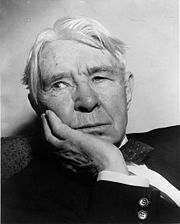Carl Sandburg's Human Design Chart
1/3 Sacral GeneratorAmerican writer, poet and biographer well-known for his famous biography, “Abraham Lincoln: The War Years” in 1939. The following year, Sandburg was awarded a Pulitzer Prize in History for the biography, and the year after that, a Pulitzer Prize for his poetry. He was one of the most visible poets in the U.S., appearing on radio and television. Grounded in a concern for social justice, Sandburg is considered to be an authentic American poet in the same tradition as Walt Whitman.
Sandburg was the son of Swedish immigrants. His father, August, worked as a blacksmith helper for Chicago, Burlington and Quincy Railroad. Even though his hard-working dad toiled and sweated to provide shelter and food for the family, economic hardships were always present. The boy learned to carry a hatred for the injustices embedded in the capitalist economic system felt by laborers like his father.
Hard times meant that Sandburg had to leave school in order to find employment. He tried to learn a trade in hometown of Galesburg, IL, but he lacked the ability and skills. He traveled around the country doing various jobs. He became a soldier during the Spanish American War in 1898. He was a fireman, hobo, and lecturer on the lyceum circuit. He helped to organize the Wisconsin Democratic Party. He went to Lomlard College in Galesburg on a government-supported grant.
In 1907, he met his wife Paula, a school teacher and fellow socialist. In 1912, he moved to Chicago and became a journalist for the Chicago Daily News. In 1915, “Chicago Poems” was published. The following year, Sandburg left the Socialist movement, a dedicated patriot when the U.S. entered WW II. He would later write of the bitter waste of war in his poetry. In the 1920s, he began to review films for the newspaper. He wrote a classic children’s book, “Rutabaga Stories.”
In 1926, his first book on Abraham Lincoln was published entitled, “Abraham Lincoln: The Prairie Years.” In the 1930s, Sandburg worked on his four-volume sequel, “Abraham Lincoln: The War Years,” which appeared on the eve of WW II. In 1936, his poetry, “The People, Yes” was published. “Remembrance Rock” was received by his American readers in 1948.
Sandburg’s wife, Paula Steichen, was the sister of the photographer Edward Steichen. Paula, a Phi Beta Kappa graduate from Wisconsin University was a school teacher when she met her husband in 1907. She devoted her life to Sandburg, encouraging his poetry and keeping his domestic environment to his liking. Her photographer brother became a friend and collaborator to her husband. Sandburg and his wife had three children and their relationship lasted for 60 years despite his wandering for months away from his home and his friendships with other women. His wife preferred to immerse herself in the domestic details of the house in Flat Rock, North Carolina.
Sandburg died on 7/22/1967 at Flat Rock, North Carolina.
Link to Wikipedia biography
Discover More Famous People
Browse and analyze over 55,000 public figures and celebrities.
Ra Uru Hu
5/1 Manifestor
Martha Stewart
4/6 Manifestor
David Lynch
4/6 Generator
Barack Obama
6/2 Projector
Steve Jobs
6/3 Generator
Vladimir Putin
5/1 Manifestor
Kim Kardashian
3/5 Generator
Michael Jackson
1/3 Projector
Marilyn Monroe
6/2 Projector
Ariana Grande
2/4 Projector
Oprah Winfrey
2/4 Generator
Johnny Depp
2/4 ManifestorWhat is HumanDesign.ai and how does it work?
Curious what makes Carl Sandburg tick? HumanDesign.ai instantly maps their exact birth data into a fully interactive clickable bodygraph chart, letting you hover or tap every center, channel, and gate for plain-language explanations. Bella, the platform’s built-in AI guide, adds context in real time, translating complex mechanics into everyday insights so you can see how Carl Sandburg’s strengths, challenges, and life themes play out on-screen.
The same tools are waiting for you. Generate your own Human Design Chart in seconds, open a library of 2000+ suggested questions, and chat with Bella as often as you like to decode your design, daily transits, and even relationship dynamics.
Want to compare energies? Save unlimited charts for friends, family, or clients, then ask Bella to reveal compatibilities, composite patterns, or coaching tips, all in one conversation thread.
Start free with core features, or unlock our Personal and Pro plans for deeper dives: unlimited Q&A, celebrity chart search spanning 55,000+ public figures, white-label PDF reports, branded content generation, and a professional profile with built-in booking for practitioners. Whether you’re exploring your own potential or guiding others, HumanDesign.ai delivers an ever-expanding toolbox of AI-powered insights—no spreadsheets, no jargon, just clarity at your fingertips.
Ready to see yours? Signup for FREE today!

